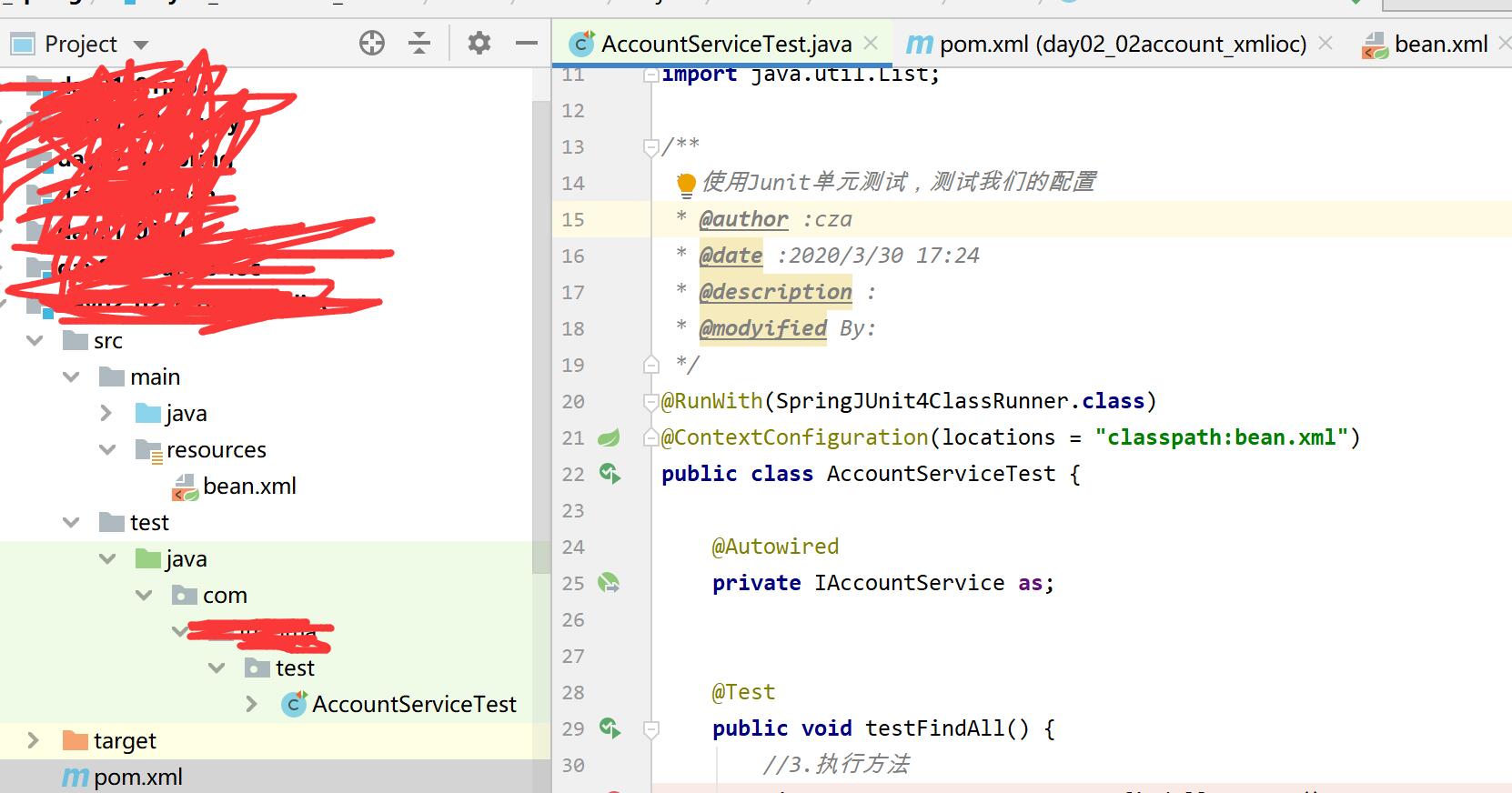1、配置来至bean.xml
@RunWith(SpringJUnit4ClassRunner.class)
@ContextConfiguration(locations = “classpath:bean.xml”) //表示在编译完成后在类路径下的beean.xml文件
public class AccountServiceTest {
@Autowired
private IAccountService as;
@Test
public void testFindAll() {
}
}
bean.xml的内容
http://www.springframework.org/schema/beans/spring-beans.xsd”>
pom.xml的配置
jar
org.springframework
spring-context
5.0.2.RELEASE
org.springframework
spring-test
5.0.2.RELEASE
commons-dbutils
commons-dbutils
1.4
mysql
mysql-connector-java
5.1.6
c3p0
c3p0
0.9.1.2
junit
junit
4.12
test
目录的展示

2.配置来至Class
/**
* 使用Junit单元测试,测试我们的配置
Spring整合junit的配置
1.导入spring整合junit的jar(坐标)
2.使用Junit提供的一个注解把原有的mian方法替换了,替换成spring提供的@Runwith
3.告知spring的运行期,spring的ioc创建是基于xml还是注解的,并且我说明位置
@ContextConfiguration
localtions:指定xml文件的位置,加上classpath关键字,表示在类路径下
class:注定注解类所在的位置
当我们使用spring 5.x版本的时候,要求junit的jar必须是4.12及以上
*/
@RunWith(SpringJUnit4ClassRunner.class)
@ContextConfiguration(classes=SpringConfiguration.class)
public class AccountServiceTest {
@Autowired
private IAccountService as;
@Test
public void testFindAll() {
//init();
//3.执行方法
List accounts = as.findAllAccount();
for(Account account : accounts){
System.out.println(account);
}
}
SpringConfiguration类
Configration
作用:指定当前类是一个配置类
细节:当配置类作为AnnotationConfigApplicationContext对象创建的参数时,该注解可用不写
ComponentScan
作用:用于通过注解指定spring在创建容器时要扫描的包
属性:
value:它和basePackages的作用是一样的,都是用于指定创建容器时要扫描的包我们使用次注解就等用于在xml中配置了:
Bean
作用:用于把当前方法的返回值作为bean对象存入spring的ioc容器中
属性:
name:用于指定bean的id。当不写时,默认值是当前放的名称
细节:
当我们使用注解配置方法时,如果方法有参数,spring框架会去容器中查找有没有可用的bean对象。
查找的方式和Autowired注解的作用是一样的。
Import
作用:用于导入其它的配置类
属性:
value:用于指定其他配置类的字节码
当我们使用Import的注解之后,有Import注解的类就是父配置类而,导入的都是子配置类
PropertySource
作用:用于指定properties文件的位置
属性:
value:指定文件的名称和路径
关键字:classpath,表示类路径下
*/
@ComponentScan(basePackages = “com.ruankao”)
@Import(JdbcConfig.class)
@PropertySource(“classpath:jdbcConfig.properties”)
public class SpringConfiguration {
}
public class JdbcConfig {
@Value(“${jdbc.driver}”)
private String driver;
@Value(“${jdbc.url}”)
private String url;
@Value(“${jdbc.username}”)
private String username;
@Value(“${jdbc.password}”)
private String password;
/**
* 用于创建一个QueryRunner对象
* @param dataSource
* @return
*/
@Bean(name = “runner”)
public QueryRunner createQueryRunner(@Qualifier(“dataSource2”) DataSource dataSource){
return new QueryRunner(dataSource);
}
/**
* 创建数据源对象
*/
@Bean(name= “dataSource”)
public ComboPooledDataSource createDataSource() {
try {
ComboPooledDataSource ds=new ComboPooledDataSource();
ds.setDriverClass(driver);
ds.setJdbcUrl(url);
ds.setUser(username);
ds.setPassword(password);
return ds;
} catch (PropertyVetoException e) {
//e.printStackTrace();
throw new RuntimeException(e);
}
}
/**
* 创建数据源对象
*/
@Bean(name= “dataSource2”)
public ComboPooledDataSource createDataSource2() {
try {
ComboPooledDataSource ds=new ComboPooledDataSource();
ds.setDriverClass(driver);
ds.setJdbcUrl(url);
ds.setUser(username);
ds.setPassword(password);
return ds;
} catch (PropertyVetoException e) {
//e.printStackTrace();
throw new RuntimeException(e);
}
}
}
jdbcConfig.properties
jdbc.driver=com.mysql.jdbc.Driver
jdbc.url=jdbc:mysql://localhost:3306/ruankaowang?characterEncoding=utf-8
jdbc.username=root
jdbc.password=123456